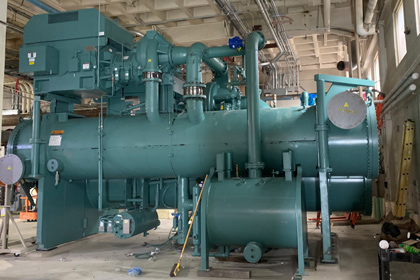The University of Virginia is committed to being carbon neutral by 2030 and fossil fuel-free by 2050. These ambitious goals build on a decade of climate action at UVA, which set its first greenhouse gas reduction goal in 2011.
Since that time, the University has reduced carbon emissions by 43% from 2010 and is developing additional climate action strategies for the decade ahead. Over the past year, stakeholders from across the University have come together to support two complementary initiatives — development of the UVA 2030 Climate Action Plan and support of a long-term Strategic Thermal Energy Study.
The Climate Action Plan is a roadmap for the University to achieve its 2030 carbon-neutrality goal. With more than 550 buildings spanning 18 million square feet and numerous construction projects supporting growing schools and programs, UVA’s environmental footprint would continue to increase without deliberate action.



The University Hospital’s new South Tower achieved LEED Silver certification in the past year and is one of 78 LEED certified projects at the University (Photo by Sanjay Suchak / University Communications). UVA’s Facilities Management Fleet has accelerated its climate action leadership and been recognized as one of the greenest fleets in the country by the annual Green Fleet Awards (Contributed photo). The use of heat recovery chillers (like this one pictured at the North Plant) is one strategy being examined by the Strategic Thermal Energy Study to eliminate fossil fuels within UVA’s district energy systems (Contributed photo).
Facilities Management teams have been instrumental in efforts to reduce this impact through multiple, interconnected programs focused on reducing energy use, water consumption, waste and toxic materials.
UVA’s Building Efficiency Program (formerly known as “Delta Force”), composed of an internal team of Office for Sustainability engineers and Facilities Management staff, provides energy retrofits for existing buildings at no upfront cost. Over the past three years, the program has invested $6.3 million in new energy efficiency projects on Grounds. With over 10 years of similar investments, this program has achieved $21.6 million in energy cost savings in the past three years.
In 2022, Facilities Management and the Office for the University Building Official updated UVA's Facility Design Guidelines and Green Building Standards to support the 2030 sustainability goals. These updates include requirements for prohibiting on-site combustion of fossil fuels and for new buildings and major renovations to meet high performance, low-energy targets.
The Facilities Management Fleet team has accelerated its climate action leadership by procuring 22 low-emissions vehicles with seven more due to arrive soon. Additional innovations related to driver training and analytics has seen UVA’s FM Fleet emerge as a leader and one of the greenest fleets in the country as recognized by the annual Green Fleet Awards.
The Strategic Thermal Energy Study is a longer-term analysis focused on eliminating fossil fuels within UVA’s district energy systems. This study will inform the Climate Action Plan’s strategies that specifically address reduction of carbon use supporting the UVA energy supply.

One of these strategies includes the installation of heat recovery chillers, which simultaneously produce both hot and chilled water for cooling and heating buildings as needed, boosting efficiency and decreasing energy and water consumption.
The UVA Academic Low Temperature Hot Water Conversion project, supported by Capital Construction & Renovations and Energy & Utilities, included the installation of an 1,800-ton heat recovery chiller at the North Chiller Plant in May 2022. That overall project will result in $1 million dollars of annual cost savings, plus 19,000 metric tons of avoided carbon dioxide emissions and over 20 million gallons of water saved each year.
Additional strategies being examined include connecting and expanding thermal loops as well installing geo-exchange on Grounds, which is the process of using deep boreholes in the ground to store heat produced in the summer for heating in the winter.
